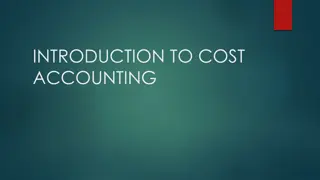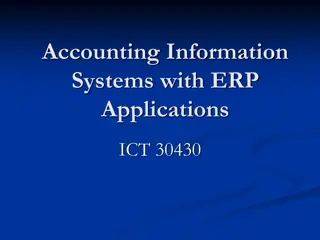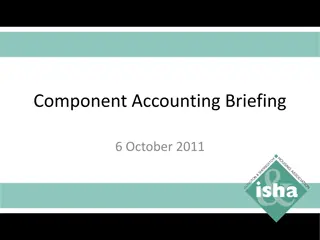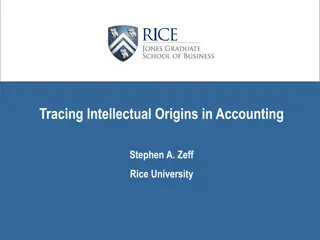Understanding Cost and Management Accounting
Accounting encompasses recording, classifying, and summarizing business transactions, while financial accounting focuses on interpreting financial data for determining profits. Cost accounting involves tracking expenses for product cost determination, and management accounting provides data for decision-making. The evolution of cost accounting includes methods for calculating costs per unit in different industries.
Download Presentation

Please find below an Image/Link to download the presentation.
The content on the website is provided AS IS for your information and personal use only. It may not be sold, licensed, or shared on other websites without obtaining consent from the author. Download presentation by click this link. If you encounter any issues during the download, it is possible that the publisher has removed the file from their server.
E N D
Presentation Transcript
COST AND MANAGEMENT ACCOUNTING
INTRODUCTION ACCOUNTING accounting is wider term and includes recording, classifying and summarizing of business transactions in terms of money, preparation of financial reports and analysis and interpretation of these reports for the information and guidance of management Branches of accounting the business accounting system consist of 3 parts Financial accounting Cost accounting Management accounting
Financial accounting financial accounting may be defined as the science and art of systematically recording, classification and summarizing business transactions of financial character and finally interpreting the results for determining the financial profits or loss at the end of an accounting year. it also shows the financial position of the firm, and thus, records and reports financial statements-balance sheet, income statements and cash flow statements.
COST ACCOUNTIN Cost is defined as the amount of expenses (actual or notional) incurred on or attributable to specified thing or activity. Cost is the measurement in monetary terms of the amount of resources used for the purpose of production of goods or rendering of services (Institute of Cost and Work Accounts (ICWA) India). A cost is the value of economic resources used as a result of producing or doing the things costed. (W M Harper) This activity of the cost will reflect in the manufacturing of the product or rendering of the services which will cover expenditures under various heads.
COST ACCOUNTING MEANING cost accounting is concerned with recording, classifying and appropriate allocation of expenditure for the determination of the cost of products or services, and for the suitably arranged data for purposes of control and guidance of information to management for decision making. Cost means the price paid for something Cost ascertain is computation of actual cost incurred. Cost estimation is process of determining cost of goods and services.
EVOLUTION OF COST ACCOUNTING For examples: salary, materials, other expenses etc. In the case of service industry, they are interested in the cost of ascertaining the cost of the services it renders. The cost per unit is arrived by dividing the total expenditure incurred to the total number of production or the service rendered. This method can be used when there is only one product. If the manufacturing company manufactures more than one product, it becomes imperative to split the total cost among the number of products.
COST, COSTING, COST ACCOUNTING AND COST ACCOUNTANCY: COST: Cost is defined as the amount of expenses (actual or notional) incurred on or attributable to specified thing or activity. For example Cost of preparing one cup of tea is the amount incurred on the elements like material, labor and other expenses, similarly cost of offering any services like banking is the amount of expenditure for offering that service. Thus cost of production or cost of service can be calculated by ascertaining the resources used for the production or services.
Costing: Costing is defined as, the techniques and processes of ascertaining costs Chartered Institute of Management Accountants (CIMA). Costing means finding of cost by any process or technique. (The According to Wheldon, Costing is classifying, recording, allocation and appropriation of expenses for the determination of cost of products or services and for the presentation of suitably arranged data for the purpose of control and guidance of management. Cost Accounting :- Cost Accounting primarily deals with collection, analysis of relevant of cost data for interpretation and presentation for various problems of management. Cost accounting accounts for the cost of products, service or an operation. It is defined as, the establishment of budgets, standard costs and actual costs of operations, processes, activities or products and the analysis of variances, profitability or the social use of funds .
Cost Accountancy: CIMA defines Cost Accountancy as the application of costing and cost accounting principles, methods and techniques to the science, art and practice of cost control and the ascertainment of profitability as well as presentation of information for the purpose of managerial decision making . Cost Accountancy is a science as it is a knowledge which a cost accountant should possess to carry out his duties and responsibilities. It is an art as it required skills by the cost accountant to apply principles of cost accountancy to various managerial problems like price, expenditures etc. Practice refers to the efforts taken by the Cost Accountant in the field of cost accountancy. Along with the Theoretical knowledge, cost accountant should possess sufficient practical training and exposure to real life costing problems.
SCOPE OF COST ACCOUNTING Costing: It is ascertainment of cost of products, processes, jobs services etc.it is the most important function of cost accounting. Cost Recording: It is a maintaining record of all the cost (expenses) incurred during the process of the production of the final products/ services. Such records are kept on the basis of double entry system. Cost Analysis: All the costs that are recorded are analyzed and categorized separately. Example: Direct and Indirect Costs, Fixed and Variable Costs, etc.
Cost Control: Cost Accounting, compares the actual cost and standard cost, the difference between the two are analyzed and used for cost control purpose. Cost Report: Cost accounting generates periodical reports such as weekly, monthly reports that is used by the management for taking decisions. These reports are used for planning and controlling, performance appraisal and management decision making. Cost Audit: It is the verification of cost accounts and to check on the progress of cost accounting plan. Its main focus is on the expenditure and efficiency of performance.
IMPORTANCE OF COST ACCOUNTING: Cost accounting has many importance. Specially, the following parties are benefitted from it. Importance to management Management is highly benefitted with the introduction of cost accounting. It helps to ascertain the cost and selling price of the product. Cost data help management to formulate the business policies. Importance to investors Investors want to know the financial conditions and earning capacity of the business. An investor must gather information about organization before making investment decision. Importance of consumers The aim of costing is to reduce the cost of production to minimize the profit of business. Consumers get quality goods at a lower price.
Importance to Employees Cost accounting helps to fix the wages of the workers. Efficient workers are rewarded for their efficiency. It helps to induce incentive wage plan in business. Importance to Government government agencies to determine excise duty and income tax. Government formulates tax policy, industrial policy, export and import policy based on the information provided by the cost accounting.
OBJECTIVES OF COST ACCOUNTING: Ascertaining the Cost: It refers to the cost for a specific product or activity with a reasonable degree of accuracy. Determining the Selling Price: It helps in finalizing the cost of the product after which the profit margin is added by the manufacturer and thus the selling price of the product is fixed. Cost Control and Cost Reduction: It helps in improving profitability by controlling and reducing costs. This objective is important for current scenario due to increase in competition in the business world. Management in Decision Making: Taking Management decision in respect of the price of the product for which the comparison of actual and standard cost is required to analysis the causes of variation and to take corrective decisions.
Ascertaining the Profit: It helps in ascertaining the profit of the business by matching the cost with the revenue of that activity. The purpose is to determine the profit or loss of any activity on an objective basis. To Provide basis of operating policies To provide information about inefficient and carelessness To provide information about actual situation of production activity To inform the principles and procedures to be followed in Costing System To prepare comparative analysis through data collection To estimate cost To disclose and minimize the waste























